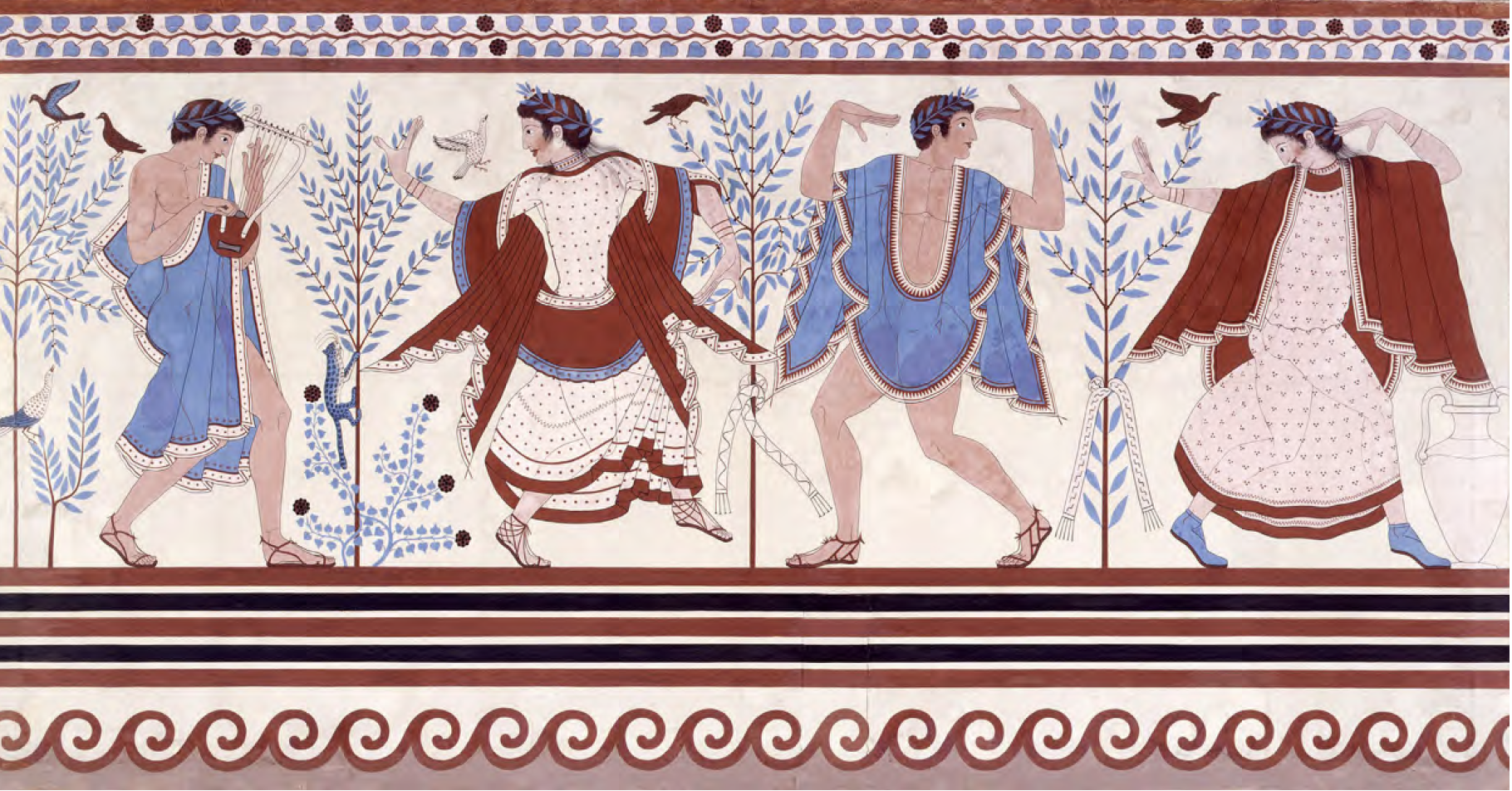Copy of Tomb Paintings of the Triclinium of Tarquinia
Artist: Carlo Ruspi
Date: 1833-copy from the original works dating back to 470 B.C.
Dimensions: 170 x 325 cm and 170 x 106 cm
Materials: Tempera painting on paper, lined with paper and silk and mounted on a frame
Description
MEDIUM PRIORITY PROJECT
The Etruscan era Triclinium tomb, located in the Monterozzi necropolis in Tarquinia, was discovered in 1830 with its paintings intact. The archeologist and artist, Carlo Ruspi, made the first drawings in 1831. In 1832, charged by the Commission of Antiquities and Fine Arts of the Pontifical Government, he conceived the idea of reproducing the entire cycle in full-scale renderings beginning with two central figures: the dancer in ecstasy and the flute (aulos) player from the right wall. In December 1833, the artist delivered the first ever complete renderings of an Etruscan tomb to the Vatican Museums. It would be on display in the newly inaugurated Gregorian Etruscan Museum in 1837. The Vatican series is the only complete collection still intact of the tomb paintings today, representing documentation of exceptional importance for understanding the original pictorial cycle. The original paintings date to 470 B.C. For conservation purposes they have been detached and are on display, as of 1949, in the National Archaeological Museum in Tarquinia.
TOTAL COST: € 32.800,22 ($ 35,050.32)
State of Preservation
Inconsistent particulate matter is present on the painted surface. Tears in the paper support and poor adhesion of pigments are on the works. These damages are due to the abnormal tension of the opencornered aluminum frames used to replace the wooden ones no longer suitable for their conservation. The dense pigments adhere poorly to the paper support and there is partial lifting of pigment in some areas.
Restoration Procedures
- Photographic campaign before and after the intervention
- Perform microaspiration of incoherent particulate matter and fix the pigments
- Detach from the aluminum frame for appropriate modifications of the same closure of microlacerations and make color balance corrections
- Reassembly on the modified frame providing protection and reinforcement of the borders
Detail
Inventory N°: 14721, 14726
Artist: Carlo Ruspi
Date: 1833-copy from the original works dating back to 470 B.C.
Dimensions: 170 x 325 cm and 170 x 106 cm
Materials: Tempera painting on paper, lined with paper and silk and mounted on a frame
Wishbook year: 2024

Copy of Tomb Paintings of the Triclinium of Tarquinia

Details
Inventory: 14721, 14726
Artist: Carlo Ruspi
Date: 1833-copy from the original works dating back to 470 B.C.
Materials: Tempera painting on paper, lined with paper and silk and mounted on a frame
Dimensions: 170 x 325 cm and 170 x 106 cm
Department: Etruscan - Italic Antiquities
Laboratory: Paper
Wishbook year: 2024
Description
MEDIUM PRIORITY PROJECT
The Etruscan era Triclinium tomb, located in the Monterozzi necropolis in Tarquinia, was discovered in 1830 with its paintings intact. The archeologist and artist, Carlo Ruspi, made the first drawings in 1831. In 1832, charged by the Commission of Antiquities and Fine Arts of the Pontifical Government, he conceived the idea of reproducing the entire cycle in full-scale renderings beginning with two central figures: the dancer in ecstasy and the flute (aulos) player from the right wall. In December 1833, the artist delivered the first ever complete renderings of an Etruscan tomb to the Vatican Museums. It would be on display in the newly inaugurated Gregorian Etruscan Museum in 1837. The Vatican series is the only complete collection still intact of the tomb paintings today, representing documentation of exceptional importance for understanding the original pictorial cycle. The original paintings date to 470 B.C. For conservation purposes they have been detached and are on display, as of 1949, in the National Archaeological Museum in Tarquinia.
TOTAL COST: € 32.800,22 ($ 35,050.32)
State of Preservation
Inconsistent particulate matter is present on the painted surface. Tears in the paper support and poor adhesion of pigments are on the works. These damages are due to the abnormal tension of the opencornered aluminum frames used to replace the wooden ones no longer suitable for their conservation. The dense pigments adhere poorly to the paper support and there is partial lifting of pigment in some areas.
Restoration Procedures
- Photographic campaign before and after the intervention
- Perform microaspiration of incoherent particulate matter and fix the pigments
- Detach from the aluminum frame for appropriate modifications of the same closure of microlacerations and make color balance corrections
- Reassembly on the modified frame providing protection and reinforcement of the borders
Media

Copy of Tomb Paintings of the Triclinium of Tarquinia

© 2025 Patrons of the Arts
in the Vatican Museums
Vatican Museums V-00120,
Vatican City State (Europe)
+39 0669864499
